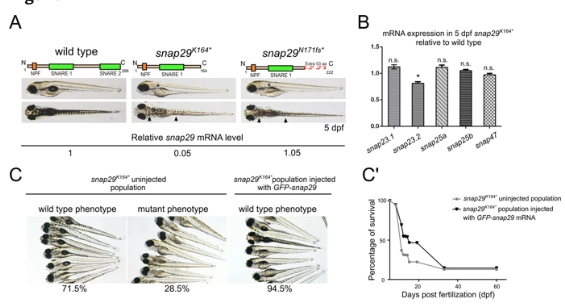Fig. 2
Generation of snap29 mutants and rescue. (A) Lateral and dorsal views of 5 dpf larvae of wild type, ENU snap29K164* mutant and CRISPR/Cas9 snap29N170fs mutants with schematic representation of predicted proteins. Asterisks in lateral views indicate lack of an inflated swim bladder, while arrows in dorsal views point to weaker pigmentation in mutants, compared to wild type. snap29 mRNA relative expression measured in extracts of 5 dpf wild type, snap29K164* and snap29N170fs larvae, and normalized on gapdh is reported below the images. snap29K164* mutants show a reduction of snap29 mRNA of about 95% compared to wild type, while no significant reduction is detectable in snap29N170fs. (B) mRNA expression of snap23.1, snap23.2, snap25a, snap25b and snap47 measured in extracts of 5 dpf snap29K164* relative to wild type. gapdh is used as normalizer. The bars in the graph show means and standard errors of the mean (SEM) of three technical replicates. P-values were computed by multiple t-test. *P ≤ 0.05. (C) Groups of 5 dpf larvae from the progeny of snap29K164* heterozygous mating. Uninjected larvae were classified according to the pigmentation phenotype. The snap29K164* uninjected population is composed by 71.5% of wild type phenotype larvae and by 28.5% of mutant phenotype larvae. The snap29K164*injected population consists of the 94.5% of phenotypically wild type larvae, demonstrating that GFP-snap29 mRNA injection rescues the mutant phenotype. (C’) Survival curve of snap29K164* populations uninjected and injected with GFP-snap29 mRNA. The percentage of survival refers to alive zebrafish larvae or adults recovered over time from the initial number of fertilized embryos. Injected snap29K164* mutants show an increase of survival compared to uninjected animals.

